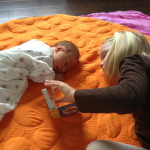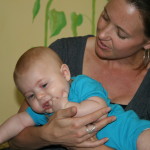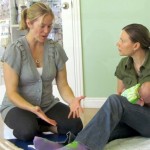
 Just yesterday, as most days, a colleague at Kids Unlimited posted an excerpt talking about the importance of tummy time. Some responses offered an alternative article written on the RIE/Janet Lansbury blog highlighting the case against tummy time. I would like to directly respond to this article. There is much of RIE, Resources for Infant Educarers, I love and respect and use on a daily basis with my patients, clients and children. However, I do not agree with their beliefs on tummy time.
Just yesterday, as most days, a colleague at Kids Unlimited posted an excerpt talking about the importance of tummy time. Some responses offered an alternative article written on the RIE/Janet Lansbury blog highlighting the case against tummy time. I would like to directly respond to this article. There is much of RIE, Resources for Infant Educarers, I love and respect and use on a daily basis with my patients, clients and children. However, I do not agree with their beliefs on tummy time.
Be advised: Throughout this post, I will be referring to the Safe to Sleep® program. This program was renamed from “Back to Sleep” and offers more recommendations to prevent SIDS and suffocation and to promote overall safe sleeping practices. Many still refer to it as “Back to Sleep.”
Here we go:

- I agree that babies should not be propped in positions they cannot get to themselves, and have a blog on that very topic regarding sitting. However, a baby cannot get to her own back unless you place her there any more than she cannot get to her tummy. Floor time is important for baby to explore sensations and movements on her back, tummy, sides, and all of the degrees in between.

- I agree that babies, for the most part, should not be in containers: The car seat should remain in the car, babies should be worn rather than strolled, they should be allowed to crawl or walk at their own pace when they are independent, and should be on the floor during a lot of awake/play time.

- I agree that our container culture (stay tuned for another blog by me on this one) is a HUGE culprit in the documented increase in plagiocephaly and torticollis. In the 1970’s 1 in 300 had plagiocephaly; now research is showing consistently 1 in 6 and occasionally 1 in 2! It truly is an epidemic…and a mostly preventable one.

- I differ from this article regarding the contribution of the Safe to Sleep® program. I believe the Safe to Sleep® program is also a major contributor to the increase in torticollis, plagiocephaly and the general unease with tummy time. It is not something to be sidelined. Before Safe to Sleep®, there was little to no anxiety about the tummy down position. Babies were on their tummy most of the time, up to 18 hours per day combined awake and asleep time. Babies liked the position because that is what they knew and they got a lot of it. Now, because the tummy down position is associated with death, there is either a conscious or at least a subconscious anxiety about that position by parents, even when baby is awake…baby picks up on that. Currently, about 35% of babies hate tummy time, parents are scared of it, and treat it like an extra workout mandated by the pediatrician rather than a place of being/knowing/relaxing and learning. It is my goal to give parents the knowledge and strategies to get back to happy tummy time.

- Babies should (and do) start tummy time Day One! When baby is born, her first position is tummy down, usually on mom’s chest. Have you ever seen a doctor/nurse/midwife put baby down on her mother on her back? It would never happen. There is NO connection that way, no way for baby to find the boob, and it seems silly to even suggest it. On the other hand, have you ever seen a baby look completely panicked on her back on the scale? Absolutely. Babies are not scared on their tummies; they are supported and loved and nourished and safe.

- Premature babies are most frequently placed on their tummies in the NICU. Tummy down is where they are best regulated, keep the most calm, where they can continue to grow and develop as best as they can. The tummy down position mimics a “squished” womb environment where babies feel enveloped; it also happens to be and where O2 saturations are usually best. In addition, Kangaroo care is all skin-to-skin, tummy-to-tummy, chest-to-chest, and side-to-side cradled. There is no focus on baby lying on his back. The back is instead touched, cradled and supported by mom and dad’s hands, gently accommodating to the roundness of the spine. Once baby is off the monitors, however, she needs to be placed on her back to sleep.

- Babies are often born with asymmetry; you can literally piece them back together like a 3D puzzle after birth to mimic how they were positioned in utero. Most of the time the head is not in the middle. And then there is the trauma of birth, which can injure cervical/neck muscles. Even a slight tear at birth scars down and becomes a much bigger problem down the road if not addressed. As a physical therapist I see many babies with torticollis and plagiocephaly/brachycephaly. My mentors will attest that before Safe to Sleep® there were FAR fewer cases. Because I’ve been a PT for 15 years, all my babies are Safe to Sleep® babies and I have no personal comparison to before that time. However, the strong general consensus is that a baby with a slight asymmetry now gets worse rather than better on their own because of a lack of tummy time. A baby on her tummy will turn her head both ways and rest her head down on the floor. Her inability to hold her head up when on her tummy is actually an asset because it naturally and slowly stretches out any tight muscles. Gravity helps her reach full range both directions. On her back, baby still doesn’t have much head control, but she definitely struggles more to turn her head the non-preferred way. Gravity is not her friend here. So she falls further and further into her preferred side, creating more tightness, more flatness, a steeper ridge to cross and a precipice/bump on the non-preferred side that she can’t stabilize/relax on. It’s a negative cycle. Babies born with asymmetry often fix themselves when on tummy and often get worse when only on back/in containers.

- Baby’s most important jobs after birth are to learn to eat, to learn to connect/bond and to learn to self regulate in a world bombarding them with new sensory information. Here’s where tummy time comes into play. And this is where I completely disagree with the assertion that being tummy down is like “having anesthesia.” Deep pressure is the best, most organizing sensory input that can be provided. It’s not called the “child’s pose” in yoga for nothing. A newborn on her tummy has much weight shifted forward on the head/face. She does not have the biomechanical capability to completely lift and turn her head, so she rests it on the floor and drags it over to the other side when she wants to turn. To us that may seem cruel, but to baby it is rich, deep sensory input to the cheeks and mouth provided by the floor and gravity. It can help to stimulate rooting and create more organization around feeding. In addition, baby’s upper arms are by her side, elbows flexed so the hand is conveniently by baby’s mouth for sucking once rooting is stimulated. Baby has been sucking on her hand since around 16 weeks in utero; she knows it and likes it; being on the floor on her tummy helps her to get her hand back to her mouth to practice sucking for feeding as well as to learn essential self regulation skills (not to be confused with self soothing). Baby can also see her hand still and supported, which is the beginning of visual regard for eye-hand coordination. Finally, sensory input provided with calm movements of her hands and feet, arms and legs are enhanced by the drag created by the floor. Baby is just learning she has body parts; she needs to experience these body parts in all positions. A more frantically moving baby is telling you she needs you, so it’s important to be aware of baby’s cues for help.

- Babies have several primitive infant reflexes, but the startle comes to mind first because this is the one that happens often and many times results in baby hitting herself in the face when on her back. A newborn still has a C-curved spine; while on her back, she doesn’t actually lie flat. She rolls slightly to the side and is unstable. This actually promotes more startle reflexes. On her tummy, the ground or mom’s chest stops the startle from going to ballistic proportions and results in fewer self knockouts…happier baby. This is one reason why swaddling is more popular now; it keeps baby from hitting herself when she startles. Before Safe to Sleep®, medical opinion was that babies be placed on their tummies for sleep. Before 1992, 85% of babies were sleeping on their tummies. The floor acted as a natural barrier, which baby seeks for comfort. (Think about the womb and the smashed baby…she tries to duplicate that in sleep, often moving to corners of the crib). Swaddling provides the “smashed” feeling while baby is on her back, but the problem with swaddling is two-fold. It’s often too restrictive (babies should be able to move) and the hands should be swaddled up by her mouth, not down by side or across chest. Baby needs access to her hands for self-regulation. It’s a tricky situation currently.

- Tummy time is not an exercise. It’s another place for baby to be and to learn. Babies get fussy there, just like they get fussy on their backs and sides or anywhere else. Of course they struggle to pick their head up. The innate desire to have head be upright, eyes on the horizon, nose on the vertical is VERY strong (from the visual and vestibular systems). But they also have a nice floor to rest down again when they fatigue. The problem is our expectations for what tummy time is, what it should look like and what baby should be doing. Babies don’t need to be in tummy time in order to try to pick their heads up, get stronger neck and shoulder muscles; that will happen, but it’s not why it’s initially most important. Unrealistic expectations and misunderstandings often lead down the road to unhappy tummy time for everyone. Baby will pick her head up when she is ready. Otherwise, she will rest her head, suck on her hand and just be. And when she is there, lie down next to her 8-12 inches from her face and be with her, enjoy her, communicate with her, read…talk…sing…bond.

- The back is also an important place to be. Baby needs to know 360 degrees of her body. However, I teach and advocate for tummy time starting day one because parents are scared and don’t understand, many babies haven’t experienced it and then one day after 3 weeks (sometimes 2 months!) are plopped down in “no man’s land” and hate it. Parents then don’t know what to do, how to do it, how long to do it, etc. It has become a mandated, unappreciated, and painful exercise. It is my mission to get rid of parent’s anxieties about it and to stop the notion that it is an exercise.
- Overall, I teach to start day one with goal to be on floor but with individualized modifications as needed on parent’s chest, in arms, on lap with simple handling techniques rather than props. I teach to limit containers as much as possible. I teach that tummy down is the position of choice on the floor (unless medical or other circumstances prevent this from being happy and successful.) I teach that when baby starts to get fussy on her tummy, first figure out WHY baby is fussy rather than assuming she doesn’t like where she is. If it is related to her position (surprisingly not the case more than 50% of the time), then help baby to change positions to side or back. I teach to put electronics away and to fully enter baby’s world rather than trying to bring baby to parent’s world. All this…among a few other things…

Bottom line is that I love what I do, feel passionate about supporting our babies’ best start, and want to share my knowledge, gained through research and practice, and grow and discuss my ideas with as many parents as I can. Tummy time is an essential piece to that puzzle that has been jeopardized by our culture and I want to help get it back!

This is the best defense of tummy time I’ve read and I wish I had found it before my daughter was born. As a first time mom it never occurred to me to have her do tummy time on the floor from day 1, though she spent a great deal of time in that position on our chests. Now she’s 4 months old and doesn’t mind it so much though she can’t stop going into superman pose with her arms behind her instead of resting more comfortably on her elbows… Hard to not feel like I sent her down the wrong path through my earlier ignorance! Thank you for the post.
Though easiest to start day 1, it’s never too late to start tummy time. It is extremely common for me to see babies in my classes who greatly prefer the superman/swimming pose rather than the pushing into the floor pose, though they should be experimenting and switching between the two at 4 months. In order to help her learn the push, make sure her arms are in a biomechanically correct position so her pectoralis major muscles can actually work. Her elbows should be at the level of or above her shoulders, not tucked behind and close to her body. If they are behind her shoulders, she will not have access to her pecs in order to push. Once aligned correctly, you can facilitate pectoralis by sliding your 4 fingers from each hand under her chest from each side and pressing the pads of your fingers in to her chest muscles. Your thumb can be used to keep her arm aligned so elbows don’t sneak back again. Also, laying her tummy down across your lap so her arms are dangling over your leg and her hands can reach the surface will give her an idea of bearing weight through her hands/arms.
Yes! Yes! Yes! I’m a fan of RIE, but their position on tummy time seemed to me like it was based on a soundbite/axiom rather than the reality of baby development. Thank you for articulating all the reasons tummy time is important!
Thanks for finding, reading the article and understanding this point of view in light of the bigger picture!
Fantastic article! Now to get these recommendations to become the status quo!
This is one of my goals! Will work tirelessly to get it done! Thank you!
My son has DS and he practically lived on the floor on his tummy from day 1 he loved it and often slept on the floor on his tummy and in his cot. He isphysically strong properly 4 point crawled and avoided bum shuffling and other not so anatomically great methods of moving and manipulating his body positions often favoured by babies with Down Syndrome.
I LOVE hearing this!!! Thank you for sharing! Tummy time and floor time is so powerful!
My kids are grown now 24-16 and some slept in their tummies as they were preemies and hated sleeping on their backs. They were born just as the Back to Sleep was starting but we all needed to sleep! My kids all spent lots of time on their tummies and did well…love this as I am a NICU social worker! Keep educating this generation of parents!
Yes! It is my hope that one day the medical community allows parents to put their babies to sleep in the position they like best. Till then, tummy time when awake! Thank you!
Wow! I had been anti-tummy time and now I’m back on board. Thank you for such a thorough and well-thought-out article. Hopefully I haven’t done too much damage at 3.5 months with almost no tummy time!
You can definitely make up lost time at 3.5 months! No damage done. It’s what you do going forward, and with the proper intention that counts!
I always thought putting babies to sleep on their backs was stupid, and not a great way for anyone to get much sleep. All 3 of mine slept on their tummies, and we all slept better. I did tummy time with my first two, then found RIE and tried not to do it with my third. But she was so curious about everything, she shrieked anytime she was on her back. She wanted to be on her tummy so she could look all around and better see her older siblings. So we did tummy time with her as well since she seemed to insist on it.
Could we have this article translated and available to us in Spanish? The information is excellent and to the point. I service non English – Spanish speaking families and would love to share it with them.
This is the best blog I’ve ever read on Tummy Time. Thank you for taking the time to go into such depth about why it’s important. I do infant care and am looking for good resources on how to work with babies during the day when I see signs of torticollis. I’m finding that even if I bring it to the parent’s attention, sometimes their pediatrician dismisses it. Can you direct me to posts, videos, therapists in the Denver area that you would recommend so I could learn more?